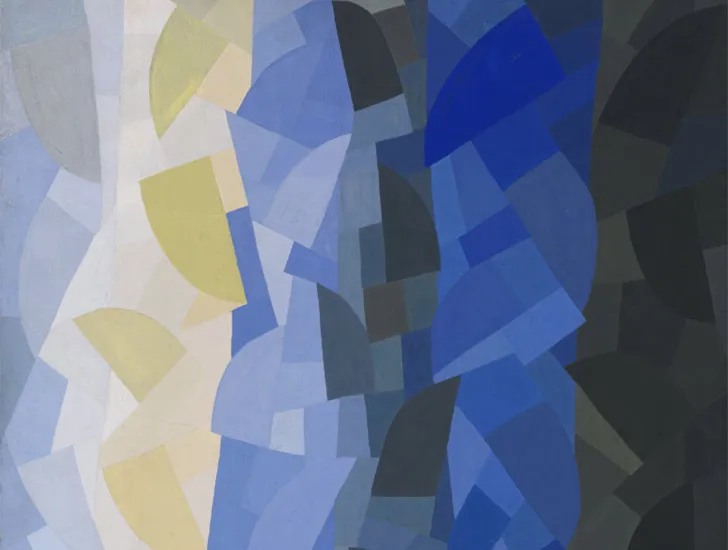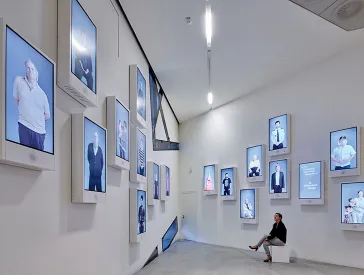Jewish Object: Applied Arts Collection
The museum’s collection includes a diverse range of three-dimensional objects, from simple everyday objects and mass-produced commodities to unique items that showcase sophisticated artistic design. In the context of a Jewish museum, these objects become “Jewish objects” be it through the self-definition of their previous owners or curatorial perspectives.
Historic and Thematic Focus
Our collection focuses on objects that were created by German-Jewish artisans or companies. We are also interested in how artists’ experiences of migration are reflected in their object design.
Most of the objects in the collection date from the late nineteenth century onwards. They range from high-quality ceramic and silver pieces by individual artists to mass-produced goods from German-Jewish manufacturers.
The main focus is on German-Jewish contributions to applied arts from 1890 to 1936, especially to various schools of design such as the Bauhaus movement, the Reimann School, and the Bezalel Academy of Arts and Design in Jerusalem, as well as the industrial production of household objects. Ceramics, silver and textile pieces, book illustrations, typography, graphic design, product design, fashion and jewelry are all represented.
Our collection also features works by the Berlin silversmith Emmy Roth (1885–1942), one of the most important representatives of her craft in Germany.
Coffee and tea service made of embossed silver and horn, Berlin, 1931; Jewish Museum Berlin, photo: Jens Ziehe Read our essay for more information
With respect to artists who were able to emigrate from Nazi Germany, we aim to trace their destinations and how they continued to practice their professions elsewhere.
A significant addition to our collection was a large donation of ceramics from the family of the innovative artist Margarete Heymann-Loebenstein (later Marks, 1899–1990), which she created in Germany and England.
Ceramic wall clock by Margarete Heymann-Loebenstein, made in her workshop in Marwitz, Mark Brandenburg, 1930; Jewish Museum Berlin, gift of Frances Marks, photo: Jens Ziehe
Research
We also conduct research on the work of German-Jewish artists who were forced to emigrate from Germany. For instance, David Heinz Gumbel, Ludwig Yehudah Wolpert, Victor Ries, Eva Samuel and Hedwig Grossmann went to Palestine and, later, to Israel, while others, such as Hermann Gurfinkel/Garfield, emigrated to the United States. Conversely, we are also interested in the works of Israeli artists who have moved to Berlin in large numbers.
Michal Friedlander, Curator of Judaica and Applied Arts, on her research on forgotten ceramists; Jewish Museum Berlin
How can I conduct research using the museum’s archive, collections, and library?
Our Reading Room is open to the public. You can also research using our library’s holdings and some of our collection’s holdings online. To view additional holdings, please contact the responsible curators.
How can I donate objects, photographs, and documents to the museum?
Do you own materials related to Jewish culture and history in Germany that could be of interest to us? We would be delighted to hear from you!
I would like to depict or borrow an object from your collections. Who should I contact?
Your contacts for photo permissions are Valeska Wolfgram and Birgit Maurer-Porat (T +49 (0)30 259 93 433, email: fotodoku@jmberlin.de). Please note that the processing time for requests can take between 4 and 6 weeks.
Loan requests must always be made six months before the beginning of the exhibition. (Extensive requests require eight months.) Requests must be made in writing to the director (Hetty Berg, Stiftung Jüdisches Museum Berlin, Lindenstr. 9-14, 10969 Berlin).
Contact
Michal S. Friedlander
Curator of Judaica and Applied Arts
T +49 (0)30 259 93 511
m.friedlander@jmberlin.de
- Address
Jewish Museum Berlin
Lindenstraße 9–14
10969 Berlin

Our Collection
An overview
- The objects we collect: information & FAQ
- Search our Collection: a growing part of our collection is digitally accessible and searchable (in German)
Details
- Archive: documenting Jewish life
- Audiovisual Media: historic sound recordings, family films and video art
- Library: books about Jewish art, culture, and history
- Fine Arts: Jewish history from the perspective of visual culture
- Photography: from the beginnings of photography to the present day
- Jewish Object: Material Culture: objects and textiles for nonreligious purposes
- Current page: Jewish Object: Applied Arts: objects produced by German-Jewish craftspeople and companies
- Jewish Object: Judaica: ritual and everyday items of religious purpose
Digital Content
- Online Showcase: digital presentation of our collection holdings, video projects, and more
- Object in Showcase: stories from our collection
See also
- The History of Our Collection: learn about the initial inspiration and transition to today's museum
- Our Collection Management: responsibilities and contact information
- Sources of Collection Holdings: in publications of the Berlin museum (1978 to 1995)
- Provenance Research: unveiling the origins of our objects
- Conservation: how to presperve our objects for future generations
